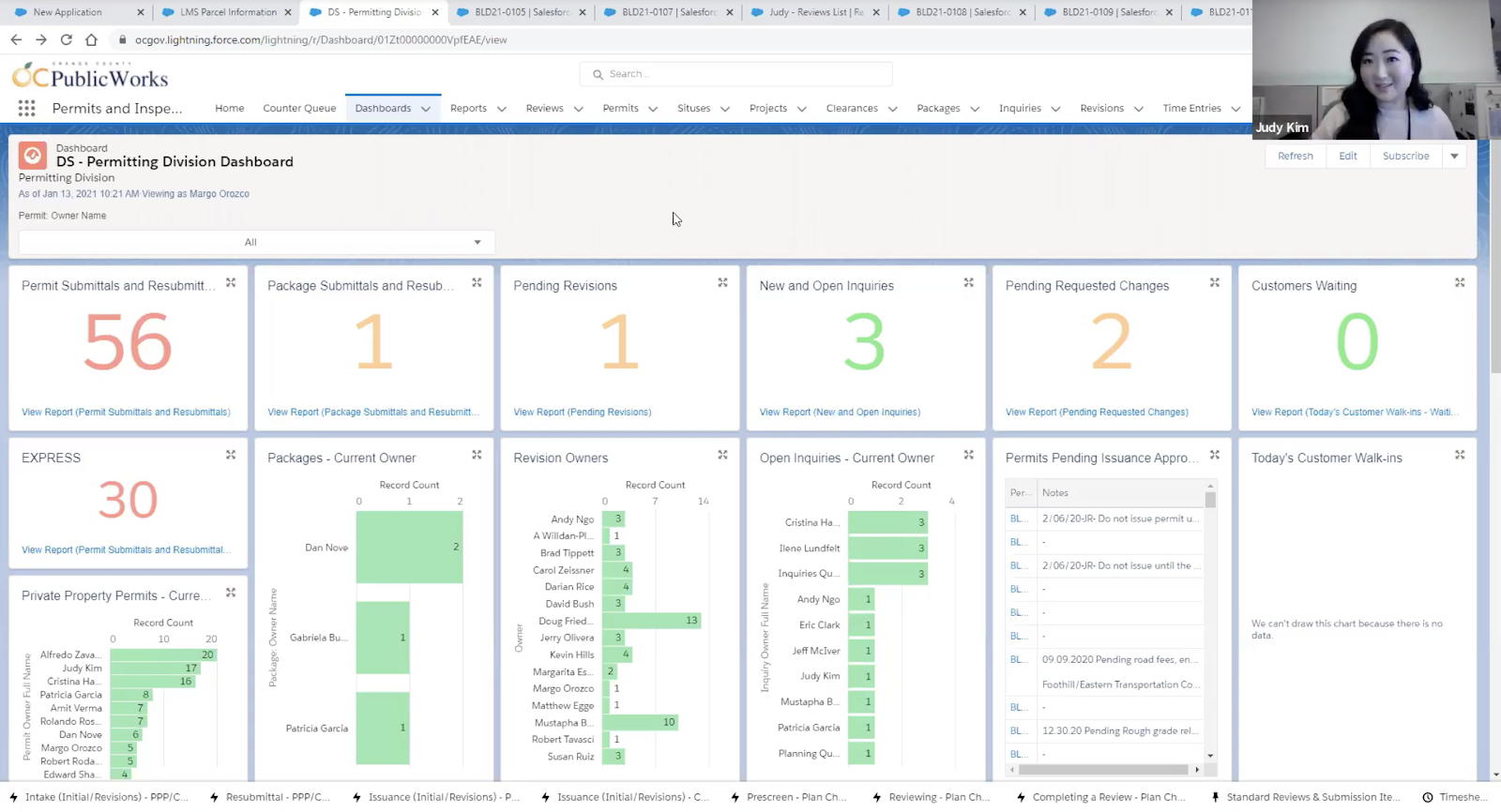Orange County, CA: How Software Contributes to Industry-Leading Service
In our educational webinar, “How Orange County, California, Maintains a 10-Day Permit Turnaround”, Permitting Managers Judy Kim, and Laree Alonso, from the Orange County Public Works Department (OCPW), shared a behind-the-scenes look at the County’s digital permitting system, and how it helps facilitate an average 10-day permit turnaround.
In the session, attendees from jurisdictions across North America got the chance to experience government permitting software through the eyes of different users, as permitting and licensing experts Judy and Laree walked viewers through a typical permitting process as an administrator, applicant, and inspector using Clariti's Enterprise permitting software.
Read on to learn more about how Orange County Public Works transitioned all services online, maintained peak service-levels through COVID-19, and how the department consistently meets ambitious permit and service timelines. Or, watch the webinar recording now.
Key Topics Covered in the Webinar:
- How the County maintains an average 10-day permit turnaround for 3 million residents with digital tools, and an efficient online process.
- How OCPW manages all citizen service requests online through the County e-services portal, removing any need for in-office requests or applications.
- A typical day for staff and citizens using the system.
- How the Public Works Department consolidated 10 business functions into one system.
- Key digital tools, their functionality, and daily use.
About Orange County and Orange County Public Works (OCPW)
Orange County, California, is home to 3.1 million residents, making it the 3rd most populous county in California, and the 6th most populous in the United States. The County Public Works Department (OCPW) manages services and projects spanning 205 square miles, or 330 square kilometres of unincorporated County area, and employs approximately 783 staff. The department has been using Clariti Enterprise since January 2019, and at present, 234 staff, and over 15,000+ members of the public are registered system users.
OCPW currently manages all private property land management permitting applications online, including:
- Reviews, permits, and inspections
- Encroachment permits within the County right-of-way
- Subdivision applications
- Discretionary applications
In the webinar, County permitting managers Judy and Laree express that despite the wide variety of permits processed by the department, and the complexity and high-level of detail required for some applications, they were able to easily accommodate complex permit requirements within their online system, and take advantage of automation that contributes to a straightforward and streamlined process for both applicants and OCPW staff.
The OCPW Digital Permitting Experience
For a county of its size, Orange County Public Works boasts an impressive average 10-day permit turnaround, attributable to a digital permitting process that streamlines and accelerates daily tasks and operations. With government permitting software, OCPW was able to consolidate 10 previously siloed services into one centralized system. And now, following their transition from an in-house system to Enterprise, the department appreciates a more transparent process for both staff and the public, and increased reporting metrics for comprehensive tracking.
A 360° Department View: 10 OCPW Business Functions Consolidated into 1 Comprehensive Online Service Portal:
 Source: Information provided by OCPW staff.
Source: Information provided by OCPW staff.
Speaking in the webinar, Laree Alonso, Administrative Manager of the OCPW Permitting Division, expressed that she was happy with her department’s pre-pandemic decision to move services online, explaining:
“It was extremely helpful during COVID… we never had to interrupt our service… [and] while a lot of cities were having to close, we were able to continue our services.”
- Laree Alonso, OCPW
Despite sudden COVID-19 restrictions, County public works services continued as normal, with staff working remotely from home or the field. Compared to previous years, the department even saw a small increase in permits processed and inspections completed. In 2020, OCPW processed over 13,000 permit applications; 1152 planning and survey applications; and completed close to 50,000 inspections. Comparably, in fiscal year 2017-2018, OCPW averaged 2000+ fewer permit applications, and 12,000+ fewer inspections. Because the County offers public works services online through their e-services portal, MyOC eServices, they were able to avoid service disruptions.
OCPW Service Metrics

Orange County's Citizen e-Services Portal

Using Government Permitting Software - Daily Processes & Features
In speaking to using government permitting software, and the simplicity of managing permit applications entirely online, Judy described, “applying for a permit is similar to the experience of ordering a pizza online”. She went on to say that a lot of manual intervention in the process has been removed, and that system automation pre-determines required information and documents needed for each specific type of permit application. This helps ensure submitted applications are complete and ready for permit/plan review, and also limits the margin for error when applying for a complex permit. Judy explained with simple customization, the department has been able to automate and streamline the entire process so it’s hassle-free for staff and applicants. Even with no IT experience or technical background, Judy and Laree both expressed their confidence in adding custom workflows into the system, and in creating custom reports.
Another major way that OCPW simplified their permitting process was with the creation of custom dashboards. Dashboards allow the entire department to visualize data, and to view what needs to be done. Each day, all department staff can access the same dashboard in order to see that day’s workload and tasks to complete -- a sort of visual to-do list. It allows staff to visualize permits/ resubmittals, see how many inspections need to be done, and more. These custom dashboards and reports allow department heads and staff to easily visualize KPI’s, key metrics, and fluctuations in demand. Plus, the reports are synced live with customer actions, so the data is always up to date.
Key Metrics and Assignments Tracked Using the Reports & Dashboards Feature
- Outstanding permit submittals and resubmittals
- New and open inquiries and current owners (staff)
- Revision owners and record count
- Permits pending issuance approval
- Number of public users since system go-live
- Public users logged in today
- Staff logged in today
- Permits & applications submitted post-system go-live
- Permits & applications submitted monthly
- Active code enforcement cases and planning applications
- Inspections performed - YTD
- Yearly permitting & application revenue
OCPW Development Services KPI's Tracked
- Response rate to code enforcement complaints within 72 hours
- First plan checks within 15 days
- Plan check timelines met
OCPW's Live Reporting Dashboard

OC's Command Center Dashboard Showing Overall Department Metrics

In addition to the highly-utilized reporting functionality of their system, hosts Judy and Laree noted the increase in transparency from a previous in-house built solution, and how it not only made it easier for staff to see what was happening across the department, but also allowed applicants complete transparency into the process. As applicants can see the progress of their application at each step of the way, the department has seen a drastic decrease in calls for status updates or other general inquiries.
As shown in the webinar, it’s not only applicants that have full visibility into their own applications. The general public also gained visibility into goings on in the community with the Research Information function: the public can now type in any address on a map and see previous permits for a property, or check on the status of projects in-progress. Laree explains that this feature allows the public to see what’s going on in the community, meaning anyone can go view the status of graffiti removal in their neighbourhood, or when a specific pot-hole is scheduled to be fixed -- they have the ability to answer their own questions regarding community projects.
Aside from the focus on the reporting and dashboards feature, and an emphasis on the noticeable improvements in process transparency, Judy and Laree go into more detail about many other key digital functionalities that contribute to an efficient process.
Other Key Functionalities Mentioned in the Webinar Include:
- Automatic System Triggers: Triggers automatically move the application to the next step in the process without manual intervention.
- Easier Communication: Applicants can directly respond to staff comments on applications within the portal.
- Online Inspections Requests: Applicants can easily request an inspection through the portal.
- Bluebeam Plan Check Integration: Syncs any red lines on a plan review into a list of corrections in the system that is easy for everyone to reference. Consolidates all comments/ corrections in one place.
- Electronic Availability of Essential Documentation: applicants can download their project files/ records through the e-portal.
